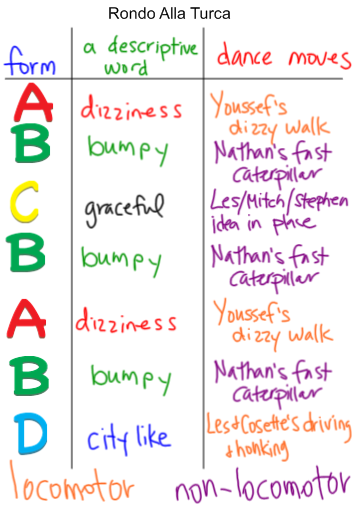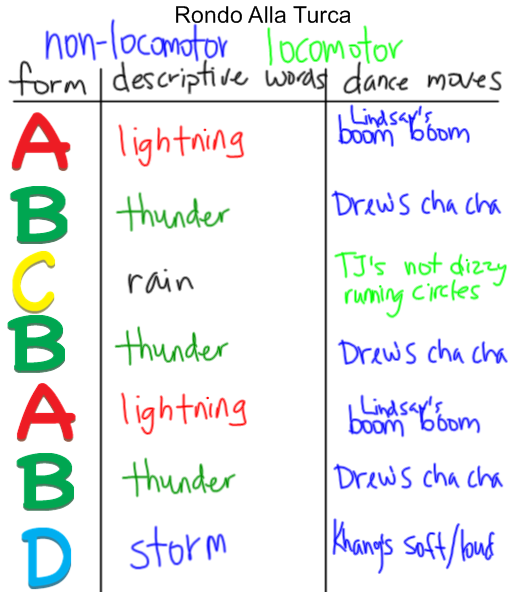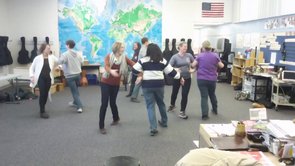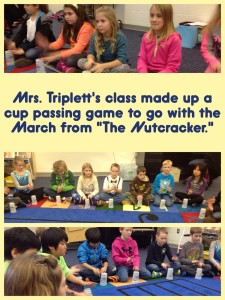

In the Hilliard City Schools music course of study, students in grades 1-6 study a different master composer each year. Second grade's composer is Wolfgang Amadeus Mozart. We spent many music classes learning about Mozart's life and times, as well as watching performance videos, listening to, and moving to selected works.
The culminating project of our Mozart study was to identify the form of Rondo Alla Turca and use the form to create an original dance. We used the SMART Board to organize our listening into the form sections and to select words that describe each section of the form. To choose both the descriptive words and the dance movements, students brainstormed and shared ideas while I jotted notes on paper. Then I selected 3-5 that I felt best matched the music, and the students then voted for their favorites. This was a time consuming process, but it was well worth the time spent. First, it allowed all of the students to have a voice in the dance creation, either through coming up with a word, a dance idea, or voting on their favorite ideas. Additionally, the students were very thoughtful in their creation and revision of the dances. We had authentic and mature conversations about how artists use criticism to refine a performance.
Below is each class's organizing chart and a video of their dance. I hope you enjoy their creative masterpieces!



Through this project, the students worked on the following Ohio Music Standards (standards marked with an asterisk are specific to the Hilliard City Schools course of study).
After studying the four orchestra families, I decided to allow my third grade students their choice of how to demonstrate their learning. Each class created a rubric that guided the projects, but it was completely up to the students whether they worked in a small group or alone, and they got to choose the medium for their final product. In order to have their idea approved, they first needed to provide me with a timeline of how they planned to complete the project in only three 50-minute music class periods (only a few groups needed more time, and they finished up during recess or literacy time in their classroom). All of the students used online resources for their research, but the final projects ranged from handwritten books and posters to Pic Collages created on iPads to Keynote and Google presentations. Most of the projects are shown in some format below under each third grade teacher's name. Click any image to view it larger, scroll through all of the images, and/or to download.
[gallery columns="4" ids="1598,1597,1596,1595,1594,1593,1592,1591,1590,1589,1588,1599,1601,1600,1586,1587"]
Click here to download Caleb and Charlie's Keynote presentation.
Click here to download Arlena and Ashmitha's Keynote presentation.
[gallery columns="4" link="file" ids="1618,1617,1616,1615,1614,1613,1612"]
Click here to download Adam's Keynote presentation.
Click here to download Mikey's Keynote presentation.
Click here to download Archith's Keynote presentation.
Click here to download Joey and Fide's Keynote presentation.
[gallery columns="4" link="file" ids="1638,1637,1636,1635,1634,1633,1632,1631,1630,1629,1627,1628,1626,1754"]
Click here to view Brandon and Jackson's Google Doc.
Below is the Google presentation, including all of the links from the OMEA/TI:ME conference session “Flipping for Elementary Music” presented February 7, 2014 at 1:15 PM.
What do music teachers do on snow days? Well, today, we danced!

Eight of the Hilliard elementary music teachers got together today to learn folk dances we can teach our students. Here are links to the resources we discussed today at our professional development.
And here is a video of the three dances from the New England Dancing Masters books listed above!
I love my job! And I am so lucky to work with other music teachers who love it as much as I do. Thanks, friends, for a fun snow day afternoon!

Every year in December, I teach themes from Tchaikovsky's ballet, The Nutcracker to grades 1-4. This year I used some old ideas and added a couple of new ones as well.
Here is Mrs. Tackett's third grade class performing their original choreography to "Trepak" at our all-school holiday sing-along on the last day before winter break. For more information about this lesson, click here.
Thanks to a great post by a music teacher I follow on Twitter (@PFPiedPiper), I found a great cup game for "Trepak" that I tried with the fourth grade classes. Two of the three classes really enjoyed it and decided to create their own cup games to the "March" from The Nutcracker. Mrs. Triplett's class's cup routine was very intricate. Mrs. John's class's was a little simpler, if any music teachers out there are interested in trying it with their classes. Both classes' videos are below.
The other fourth grade class, Mrs. Stephens's class, was not keen on the idea of making up a cup game. I'm not sure why not, but in the interest of giving the students' choice and voice, I gave them 5 minutes to convince me to do something different. One student, Christian had the idea to make up a flashlight dance. I was instantly sold! Luckily, so were the kids. My uber-supportive principal even let me use school funds to buy a class set of matching (working) flashlights. Here is their performance of "Dance of the Sugar Plum Fairy" from the sing-along.
Here are some additional photos of our Nutcracker experiences in music class this year.
[gallery link="none" ids="1493,1494,1495,1496,1497,1498,1499,1500,1501,1520"]